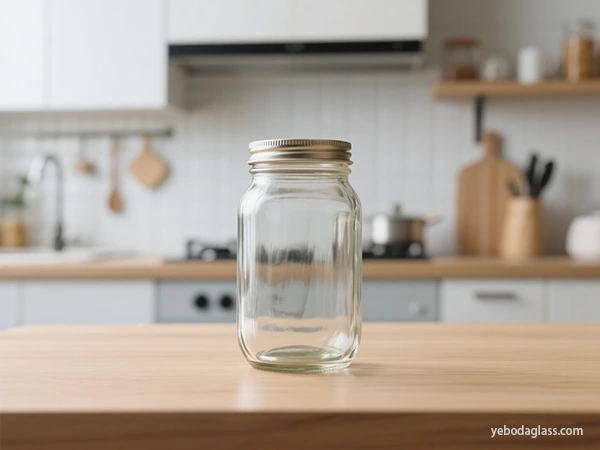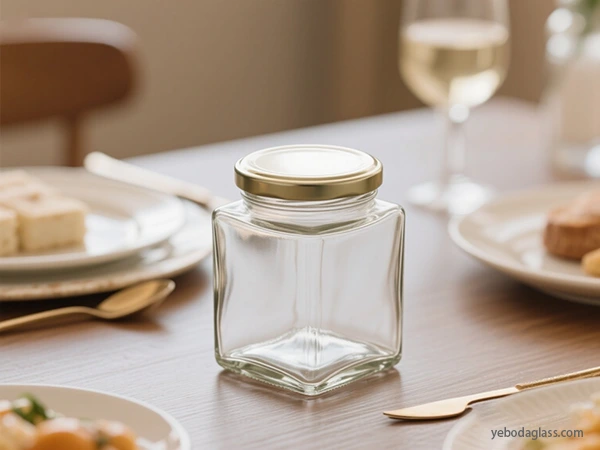Prisidėjimas
Handle the lid:
The flat lid (the part with the sealing ring) is disposable and must be used new every time. Soak it in hot water at about 82°C for a few minutes before use to soften the sealing ring for better sealing effect.

The threaded ring (the iron ring that fixes the lid) can be reused, but it must be cleaned and checked for rust or deformation. It does not need to be preheated or sterilized.
Preheating the bottle: Preventing "thermal shock" from exploding the bottle
- The purpose of preheating is to keep the bottle warm to prevent it from breaking due to the large temperature difference when pouring hot food. Common methods are:
- Water bath preheating (recommended):
Put a clean empty bottle in a large pot, add warm water to cover the bottle by 1 inch, heat to about 82°C (warm to the touch but not hot), and maintain this temperature until the food is loaded. Be careful not to let the water boil, otherwise the bottle will overheat.
Dishwasher preheating:
Put the bottle in the dishwasher, select the “heat and dry” or “sterilize” mode, and take it out immediately after the end. But be aware that not all dishwashers can reach a sufficient temperature, and it mainly relies on it to keep the bottle warm.
Oven preheating is not recommended:
The oven heats unevenly, which can easily cause the bottle to overheat locally and cause it to break, and may also burn your hands, so try not to use it.
Pre-sterilization: Do it only when necessary
Pre-sterilization is only necessary when the water bath time of high-acid food is less than 10 minutes. The most reliable method is boiling water sterilization:
- Put a easy empty bottle in a massive pot, upload water to cowl the bottle via 1 inch, and boil it over excessive heat and preserve boiling (10 mins under a thousand ft above sea level, and 1 minute greater for every a thousand toes above sea stage). After sterilization, use a canning tong to select up the bottle, pour out the water, hold the bottle heat, and fill the meals immediately. Note: Do not use a microwave to sterilize! Microwaves heat unevenly, and some places are not hot enough to kill bacteria; oven sterilization is also not recommended, the risk is too high.
- Details after canning: These things determine success or failure After the bottles are ready, the next operation is also critical. One wrong step may ruin all the previous efforts:
- Bottle while hot: After taking the bottles out of the preheated or sterilized water, fill the food immediately. If the bottles are cold, they are easy to break when hot food is poured in.
Use the right tools:
- Always use canning tongs to hold hot bottles, which can prevent burns and avoid contact with the bottle mouth and contamination.
- There are some tips for packing food
Leave enough “head space”:

There should be a gap between the bottle mouth and the food (usually 1/4 to 1 inch, depending on the recipe). This is the key to forming a vacuum seal. Insufficient gaps will cause the seal to fail.
- Don’t fill it too full: Food will expand when heated, and overfilling will cause it to overflow, dirtying the bottle mouth and affecting the seal.
- After filling, wipe the bottle mouth with a clean damp cloth. Even a little jam or oil stain may prevent the lid from sealing tightly. Pay attention to the lid:
- gently place the flat lid on the bottle mouth, and the threaded ring can be “finger-tightened” (stop when there is a little resistance). Too much force will prevent the air from being discharged, but it will not seal well. Timely treatment:
After the lid is covered, put it into the preheated canning pot immediately. Don’t leave it on the table for too long, otherwise bacteria may take the opportunity to breed.
Identify reliable recipes:
Never change the acidity, ingredient ratio or heating time in the recipe at will! It is best to use recipes from authoritative organizations (such as the National Center for Home Food Preservation in the United States), safety first.
After understanding how to sterilize canning jars, there is another important thing: choose the right canning bottle. Good bottles can make canning smoother and safer.
For example, YEBODA’s glass bottles are very suitable for home canning:
The material is solid, can withstand high temperature and pressure changes, and is not easy to break.
- It meets food grade standards and does not contain BPA, so you can rest assured to store food. The bottle mouth is smooth, fits tightly with the lid, and has a good sealing effect, which can keep food longer.
- There are various sizes and shapes, whether it is jam, pickles or meat sauce. Glass bottles can be used repeatedly, just wash them, which is both environmentally friendly and economical.
I hope this guide can help you dispel your concerns and boldly try home canning, so that you can seal the deliciousness of the four seasons in a bottle and enjoy it slowly~
- Liek ir "galio tarpą": Tarpus turi būti tarp butelio galvos ir maisto (dažniausiai 1/4 iki 1 colio, priklausomai nuo recepto). Tai yra uždangos formavimosi pagrindas. Per maži tarpai sukelia uždangos nesėkmę.
- Neužpildyk per pilnai: Maistas iššūdys, kai įkaista, ir perpilimas gali sukeliai perplūdėjimą, užkarpant butelio galvą ir pateikiant įvairių poveikį.
- Tīrīt butiņa muti: Užpildę, švelninkite butelio galvą sausą drėgną audiniu. Net ir mažas sirupo ar aliejų židinys gali sustabdyti dengos aiškiai.
- Didesni dėmesį dengai: Palaip šiek tiek dengą lygiu butelio galvai, ir skersinės apytikslė gali būti "palaip uždangota" ( sustabdyk kai yra maža prieštaravimas). Per didelis spaudimas sustabdo oro išleidimą, bet dengos neaiškiai.
- Laiko tvarka: Uždengus dengą, iškelią į išpriekai paruoštą konservavimo duobę. Neleisk ji išlikti stalo ilga laiko, kitu atveju bakterijos gali pasinaudoti šansu augti.
- Atskyri patikimų receptų: Niekad nekeisk aciditetą, medžiagų santykį ar kuojimo laiką recepte atvairiai! Geriausia naudoti receptus iš autoritetingų organizacijų (pvz., JAV Nacionalinės namų maisto konservavimo centro), pirmiausia saugumas.

viršelis
Supratę, kaip sterilizuoti konservavimo butelį, yra dar vienas svarbus dalykas: pasirinkti tinkamą konservavimo butelį. Gerūs buteliai gali padėti lengviau ir saugiau konservuoti.
Pavyzdžiui, YEBODA buteliai yra labai tinkami namų konservavimui:
- Medis yra stiprus, gali išlaikyti aukštą temperatūrą ir spaudimo kaitą, ir nėra lengvai iškrintamas.
- Jis atitinka maisto kokybės standartus ir neprisipildžia BPA, tad galite lengvai laikyti maistą.
- Butelio galva yra lygi, aiškiai prisižįmė dengai ir turi gerą uždangos efektą, kuris gali išlaikyti maistą ilgiau.
- Jų yra įvairių dydžių ir formų, ar jie būtų sirupas, marinadai ar mėsų sūris.
- Buteliai gali būti naudojami kartą, tiesiog švelninkite, tai yra ir aplinkos draugiškai, ir ekonomiškai.
norčia ši žinynas gali padėti jums išspręsti įdomumą ir drėmesnai bandyti namų konservavimą, kad galėtumėte laikyti keturių metų deramą skonį butelyje ir lėtai malautumėte~

